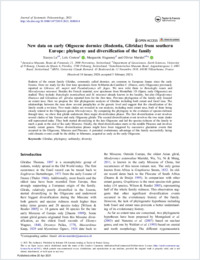New data on early Oligocene dormice (Rodentia, Gliridae) from southern Europe : Phylogeny and diversification of the family
- Lu, Xiaoyu JURASSICA Museum, Porrentruy, Jura Canton, Switzerland
- Costeur, Loïc Naturhistorisches Museum Basel, Augustinergasse 2, 4001 Basel, Switzerland
- Hugueney, Marguerite ARPA, University Claude Bernard, 43 Boulevard du 11 Novembre 1918, 69100 Villeurbanne, France
- Maridet, Olivier JURASSICA Museum, Porrentruy, Jura Canton, Switzerland
-
2021
Published in:
- Journal of Systematic Palaeontology. - 2021, p. 1-21
English
Rodents of the extant family Gliridae, commonly called dormice, are common in European faunas since the early Eocene. Here we study for the first time specimens from St-Martin-de-Castillon C (France, early Oligocene) previously reported as Gliravus aff. majori and Pseudodryomys aff. fugax. We now refer them to Butseloglis tenuis and Microdyromys misonnei. Besides the French material, new specimens from Montalban 1D (Spain, early Oligocene) are studied. They include: Butseloglis montisalbani and M. misonnei already known in the locality, but also Oligodyromys libanicus and Glirudinus aff. glirulus reported here for the first time. Previous phylogenies of the family only focused on extant taxa. Here we propose the first phylogenetic analysis of Gliridae including both extant and fossil taxa. The relationships between the taxa show several paraphylies at the generic level and suggest that the classification of the family needs a revision. Two main clades are revealed in our analysis, including most extant taxa, both of them being closely related to the Oligocene genus Microdyromys. By comparing the phylogeny to the evolution of species-richness through time, we show that glirids underwent three major diversification phases. The first diversification event involves several clades of late Eocene and early Oligocene glirids. The second diversification event involves the two main clades still represented today. They both started diversifying in the late Oligocene and led the species richness of the family to reach a peak at the end of the early Miocene. Finally, the third diversification starts in the middle Pliocene and involves mostly extant genera. These diversification phases might have been triggered by successive glaciation events that occurred in the Oligocene, Miocene and Pliocene. A potential evolutionary advantage of this family successfully facing cold climatic events could be the ability to hibernate, acquired as early as the early Oligocene.
- Faculty
- Faculté des sciences et de médecine
- Department
- Département de Géosciences
- Language
-
- English
- Classification
- Palaeontology
- License
- License undefined
- Identifiers
-
- RERO DOC 330393
- DOI 10.1080/14772019.2021.1888814
- Persistent URL
- https://folia.unifr.ch/unifr/documents/309185
Statistics
Document views: 148
File downloads:
- Lu_et_al_2021_new.pdf: 262
